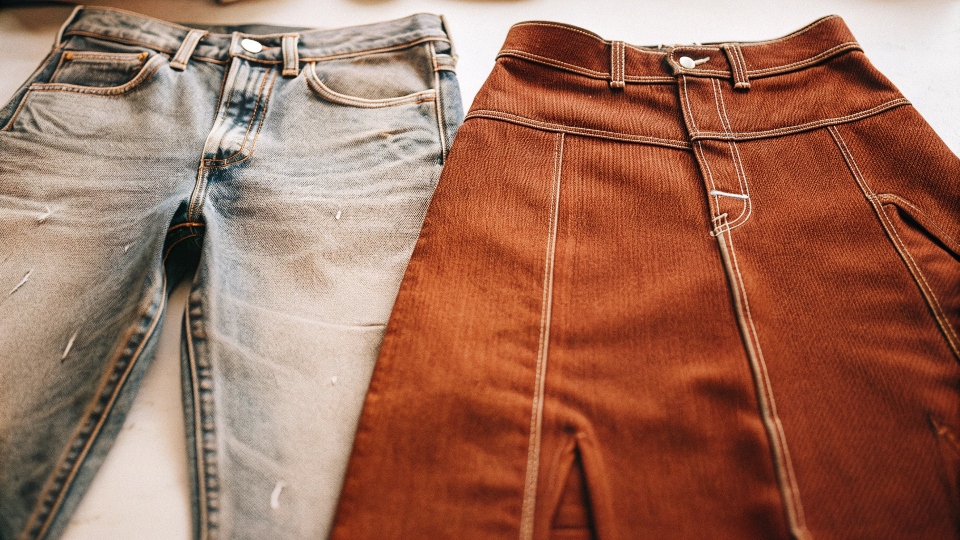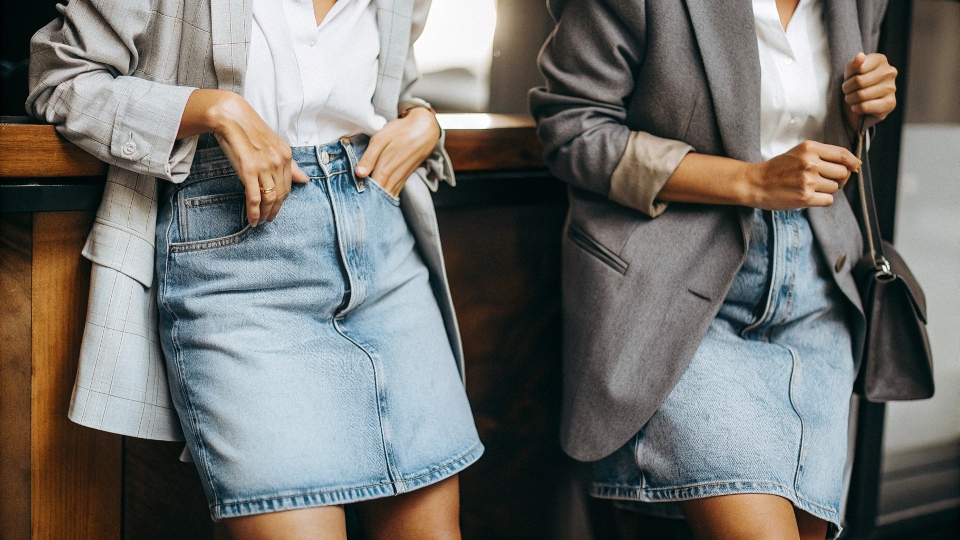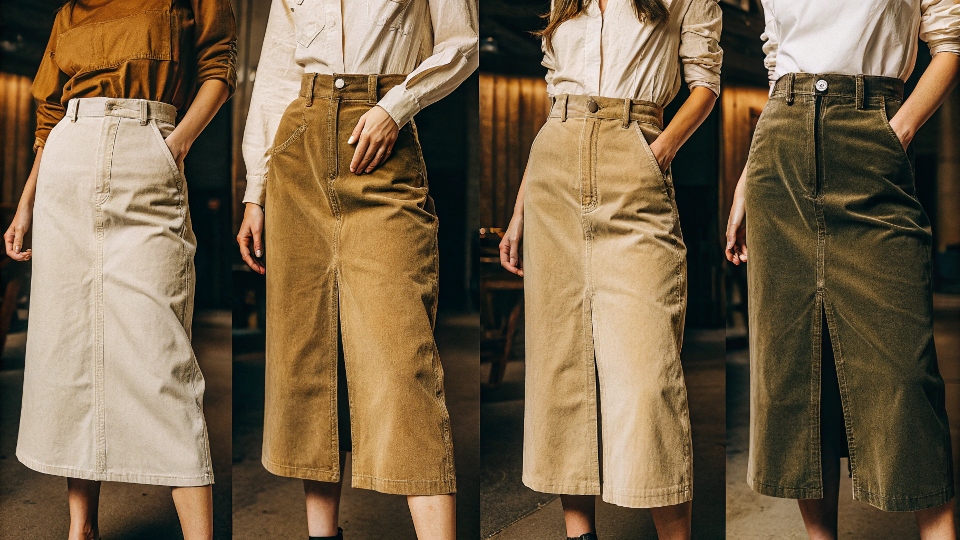Your favorite jeans don't fit anymore, but they're too good to toss. They sit in your closet, a reminder of a perfect fit you miss. What if you could give them a second life?
To make a denim skirt[^1] from jeans, carefully rip the inner leg seams, lay the jeans flat, and cut out the crotch curve. Use fabric from the leftover legs to fill the V-shaped gaps in the front and back, then sew to create your new skirt.
I've been in the denim business for over two decades, and the most sustainable pair of jeans is the one you already own. My factory, DiZNEW, produces thousands of pairs of new jeans, but my real passion is the longevity and versatility of denim.
Transforming jeans into a skirt is a classic upcycling project. It's not just about saving money or the environment; it's about creating a custom-fit garment[^2] that is 100% you. A designer like Dean values authenticity, and there is nothing more authentic than a piece you made yourself.
Your insight is spot on—it’s an easy and rewarding process. I'll guide you through the exact steps we'd use for a professional-quality finish.
How Do I Turn My Jeans Into a Skirt?
You have the perfect pair of jeans for this project but feel intimidated by the process. You're afraid one wrong snip with the scissors will ruin them forever, leaving you with nothing but scraps.
Use a seam ripper[^3], not scissors, to deconstruct the inner leg seams up to the base of the zipper. This preserves all the original fabric, allowing you to easily transform the pants into a flat panel ready for sewing.
Your insight about this process is perfect, and I want to break it down into a few simple stages. The key is patience and using the right tool. A seam ripper is your best friend here because it un-does the sewing without damaging the fabric itself.
Stage 1: Deconstruction
First, lay the jeans flat and carefully use your seam ripper to open up the entire inseam on both legs, all the way from one ankle to the other, going right through the crotch.
Then, continue to rip the main front and back center seams up to about the bottom of the zipper in the front and to a similar height in the back. Now you can lay the garment somewhat flat, but you'll see a curved shape where the crotch used to be.
Stage 2: Creating the Skirt Panels
Press the deconstructed jeans with a hot iron. In the front, overlap the two sides of the fly to create a straight, flat "fly front" panel and pin it in place. In the back, you'll see a V-shaped gap. To fill this gap, take some fabric from the skinny bottom part of the legs you cut off.
Cut a triangular piece (this is called a godet) slightly larger than the gap. Do the same for the small gap at the bottom of the front. As you suggested, using a different fabric like a printed cotton for these inserts can add a fantastic pop of color and personality.
| Insert Fabric | Vibe | Pro Tip |
|---|---|---|
| Matching Denim | Classic, seamless | Use a piece from the same jeans for a perfect color match. |
| Contrasting Denim | Patchwork, custom | Use denim from another pair for a two-tone look. |
| Printed Fabric | Bohemian, unique | A lightweight cotton is easy to sew and adds personality. |
How to turn jeans into a skirt without a sewing machine?
You're excited to try this project but the lack of a sewing machine is a major hurdle. You assume that without stitches, any skirt you make will just fall apart after the first wear.
Use a strong, permanent fabric adhesive like E6000 Fabri-Fuse or heavy-duty iron-on hem tape. These modern no-sew solutions[^4] create a bond that is durable and often flexible enough for denim, no sewing machine required.
In the factory, everything is sewn, but I have seen incredible results from modern adhesives. For a no-sew project to succeed, you need patience and the right product.
You'll follow the same deconstruction steps as above, but when it's time to put it all together, you'll reach for glue instead of a needle and thread.
First, choose your adhesive. A liquid fabric glue designed for heavy fabrics is excellent for seams because it stays flexible. Iron-on tape is great for the hem because it creates a very clean, crisp edge.
After laying out your skirt panels and pinning them, apply a thin, even bead of glue inside the seam allowance. Press the two pieces of fabric together firmly and use binder clips or clothespins to hold them tight while they cure. This clamping step is critical.
Let the glue cure for at least 24 hours before moving or wearing it. For the bottom hem, simply fold it up, place the iron-on tape inside the fold, and press with a hot iron according to the package directions.
You can even add iron-on patches over the main stress points (like where the godet meets the original jeans) for extra security and a cool, decorative touch.
Can you wear a denim skirt over 40?
You love the timeless look of a denim skirt but worry it might be "too young" for you. You see teenagers in short, frayed styles and wonder if there's a sophisticated way to wear denim skirts over 40.
Absolutely. A denim skirt is a wardrobe staple for any age. The key is to choose a classic silhouette, like an A-line or straight cut that ends at or just below the knee, in a clean, dark wash.
As someone who has seen denim trends[^5] come and go for 20 years, I can assure you that the denim skirt is forever.
The mistake is not the garment; it's choosing the wrong cut. The ultra-short, heavily distressed styles are a specific trend, but the classic denim skirt is sophisticated and timeless.
When you're making your own skirt from a pair of jeans, you have total control over the most important element: the length. I recommend cutting it to a length that hits right at the knee or mid-calf. This midi length is incredibly chic and versatile.
For the style, a simple straight or slight A-line cut is universally flattering. Stick to a pair of jeans with a darker, even wash for a more polished look.
You can pair this skirt with anything from a simple t-shirt and sneakers for a casual weekend to a silk blouse, a blazer, and ankle boots for a smart-casual office look. It’s not about age; it’s about styling a classic piece with confidence.
How to make skirts from old pants?
This project has you inspired, and now you're looking at a pile of old corduroys and chinos. You wonder if this same magical transformation can be applied to other types of pants beyond just denim.
Yes, this technique is not limited to denim. You can use the exact same method to transform corduroys, chinos, cargo pants[^6], or any sturdy trousers into a fantastic new skirt. Just adjust your needle and thread for the fabric type.
The fundamental principle of un-seaming the legs and inserting a panel works for almost any pair of pants. I've seen clients create amazing pieces from all sorts of materials. The beauty is that each fabric brings its own unique character to the finished skirt.
Adapting to Different Fabrics:
- Corduroy: These make for a perfect fall or winter skirt. The main thing to watch is the "wale," or the ribs in the fabric. When you insert your triangular panel, try to align the ribs for a more professional finish. Use a slightly heavier needle on your sewing machine.
- Chinos or Khakis: This lightweight cotton twill is very easy to work with and creates a comfortable, breathable skirt for spring and summer. It's a great fabric for beginners to practice on.
- Cargo Pants: These are a fun challenge. You can choose to keep the large side pockets as a design feature on your skirt, giving it a unique utilitarian vibe. If they feel too bulky, you can carefully remove them with your seam ripper and save them for another project.
The process remains the same: deconstruct, flatten, fill the gap, and finish the hem. This single skill opens up a whole new world of upcycling for your entire wardrobe.
Conclusion
Don't let old jeans or pants languish in your closet. With a seam ripper and a little creativity, you can turn them into a stylish, custom-fit skirt that you'll be proud to wear.











